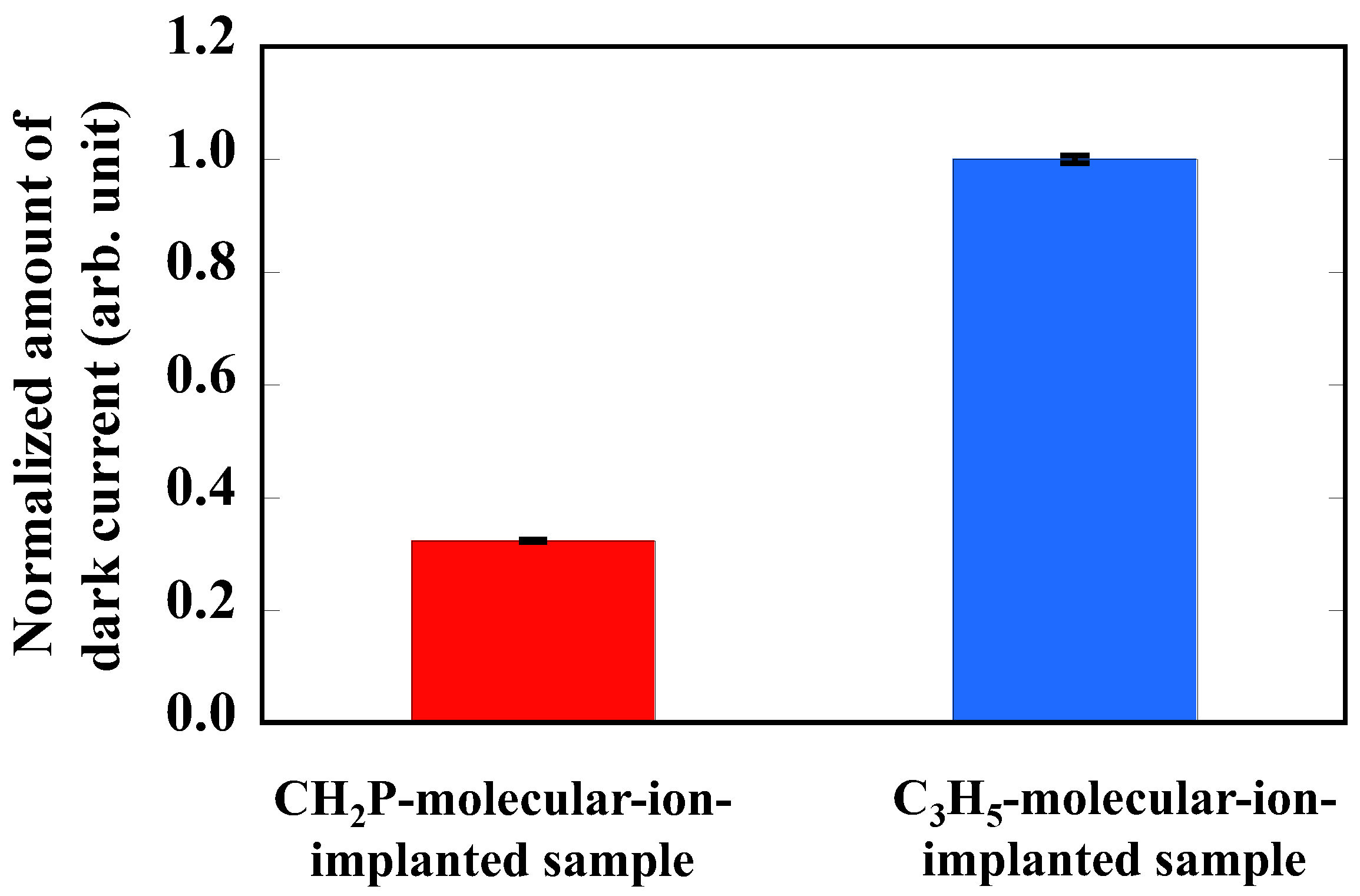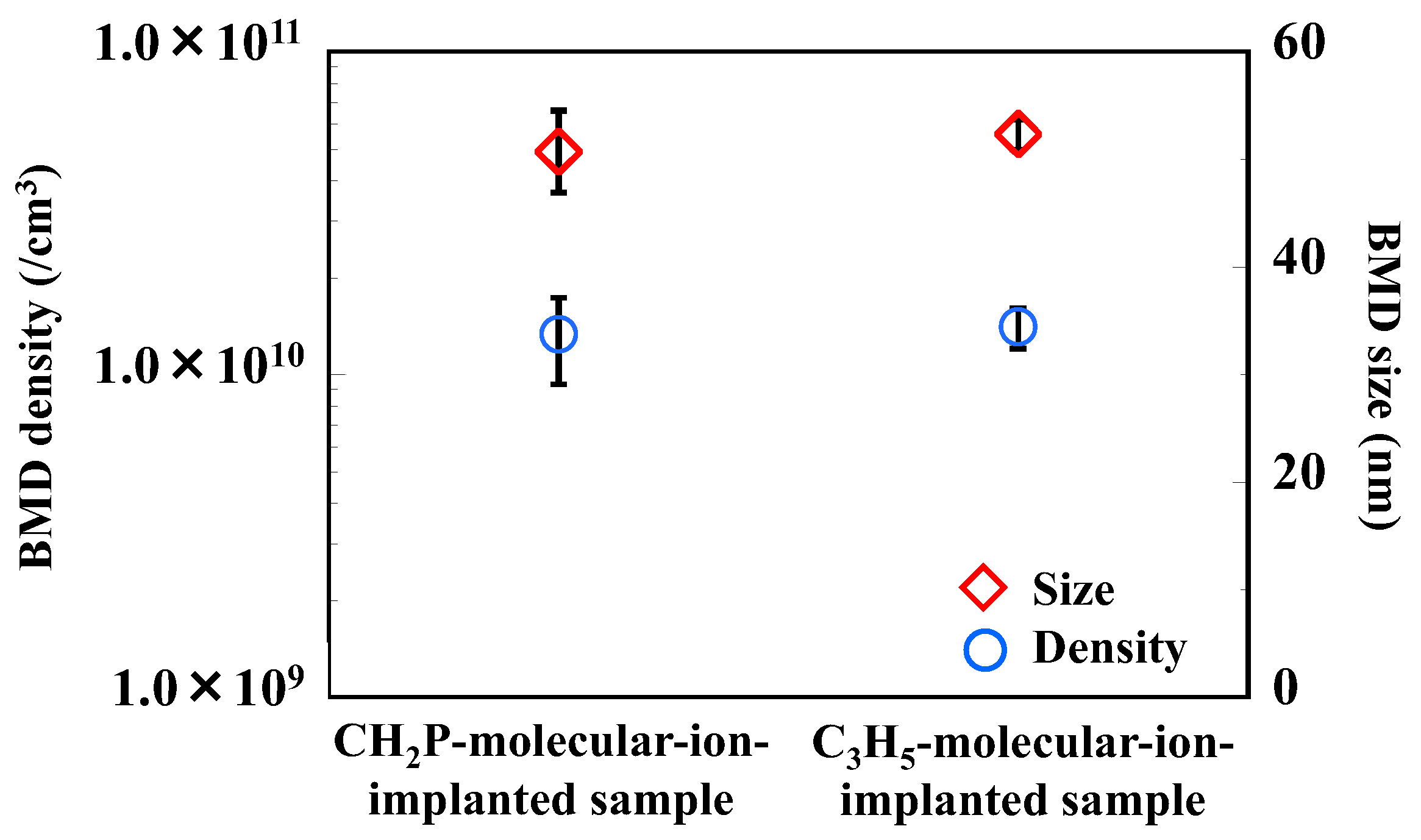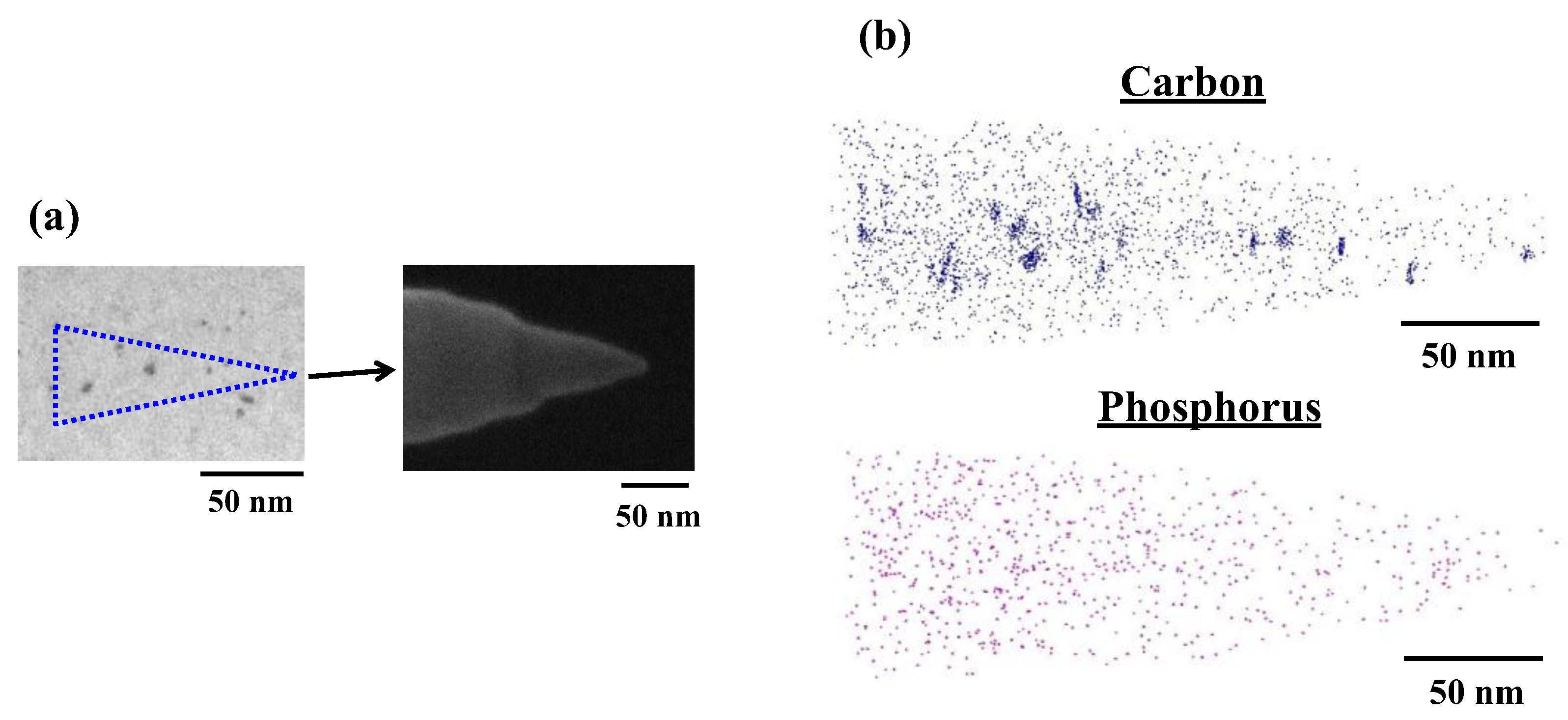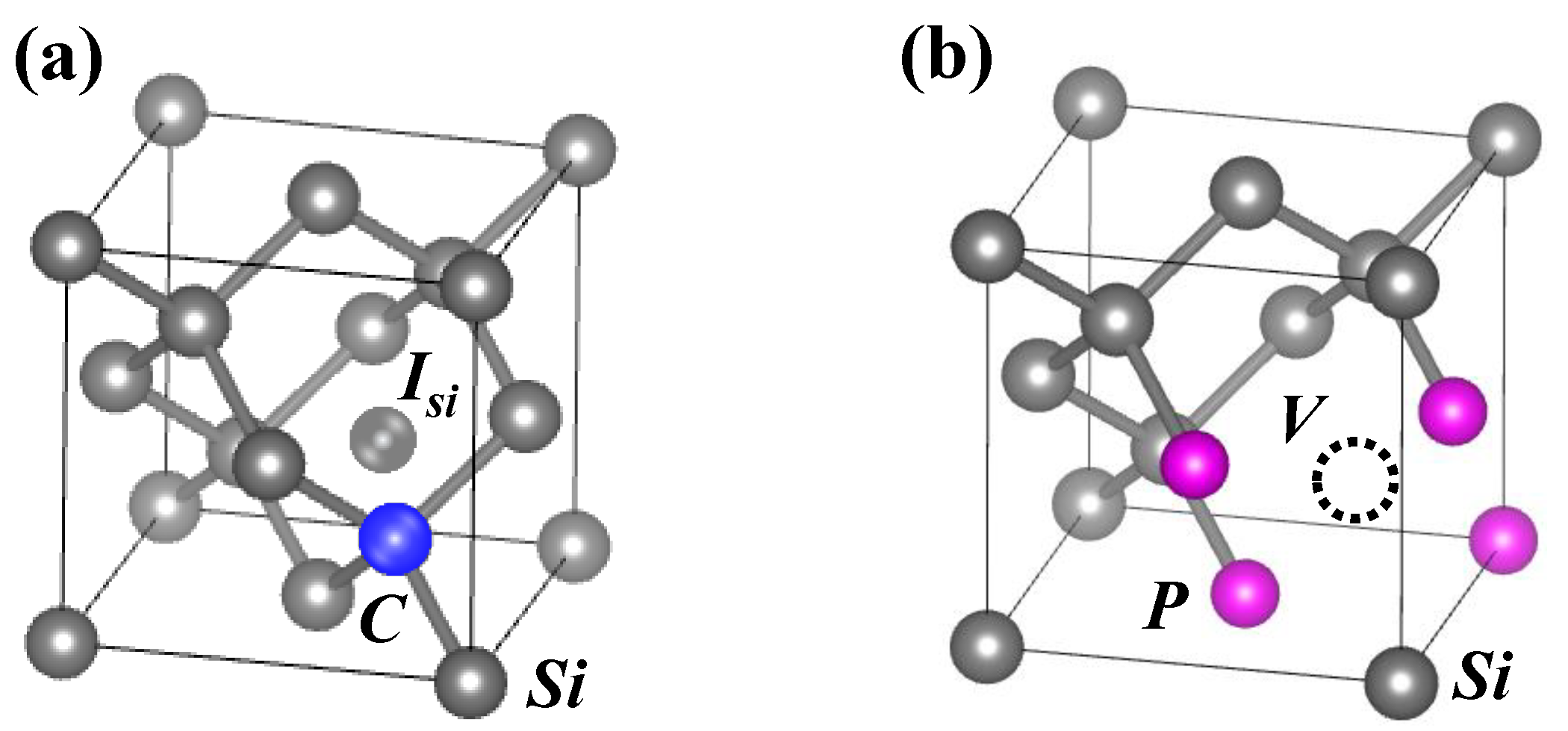Reduction of White Spot Defects in CMOS Image Sensors Fabricated Using Epitaxial Silicon Wafer with Proximity Gettering Sinks by CH2P Molecular Ion Implantation
Abstract
1. Introduction
2. Materials and Methods
3. Results
3.1. Gettering Capability of CH2P-Molecular-Ion-Implanted Epitaxial Silicon Wafer
3.2. Characteristics of CH2P-Molecular-Ion-Implanted Region after Epitaxial Growth
4. Discussion
4.1. Origin of Specific Gettering Sinks in CH2P-Molecular-Ion-Implanted Region
- (1)
- The density of black pointed defects distributed in the CH2P-molecular-ion-implanted region is higher than that in the C3H5-molecular-ion-implanted region;
- (2)
- The carbon concentration localized in the CH2P-molecular-ion-implanted region is higher than that in the C3H5-molecular-ion-implanted region; and
- (3)
- Phosphorus is deactivated by forming Pn–V complexes and does not interact with carbon distributed at the same depth in the CH2P-molecular-ion-implanted region.
4.2. Formation Model of Gettering Sinks in CH2P-Molecular-Ion-Implanted Region
4.3. Gettering Capability of These Complexes Distributed in CH2P-Molecular-Ion-Implanted Region for Metallic Impurities
5. Conclusions
Author Contributions
Funding
Institutional Review Board Statement
Informed Consent Statement
Data Availability Statement
Conflicts of Interest
References
- Mizuta, K.; Tsugawa, H.; Nakamura, R.; Kagawa, Y.; Takahashi, T.; Sakakibara, M.; Tatani, K. The Evolutionary Process for 3D Stacked CMOS Image Sensor and the Advanced Technologies. Vac. Surf. Sci. 2019, 62, 660–665. (In Japanese) [Google Scholar] [CrossRef]
- Ohta, J. Smart CMOS Image Sensors and Application; CRC Press: Boca Raton, FL, USA, 2015; Chapter 2; pp. 20–22, 52. [Google Scholar]
- Bea, J.; Lee, K.; Fukushima, T.; Tanaka, T.; Koyanagi, M. Evaluation of Cu Diffusion from Cu Through-Silicon via (TSV) in Three-Dimensional LSI by Transient Capacitance Measurement. IEEE Electron Device Lett. 2011, 32, 940–942. [Google Scholar] [CrossRef]
- Lee, K.; Bea, J.; Ohara, Y.; Murugesn, M.; Fukushima, T.; Tanaka, T.; Koyanagi, M. Impact of Cu Contamination on Device Reliabilities in 3-D IC Integration. IEEE Trans. Device Mater. Reliab. 2014, 14, 451–462. [Google Scholar]
- Kagawa, Y.; Fujii, N.; Aoyagi, K.; Kobayashi, Y.; Nishi, S.; Takeshita, S.; Taura, J.; Takahashi, H.; Tatani, K.; Kawamura, M.; et al. An Advanced CuCu Hybrid Bonding For Novel Stacked CMOS Image Sensor. In Proceedings of the IEEE Electron Device Technology and Manufacturing Conference, Kobe, Japan, 13–16 March 2018; pp. 65–67. [Google Scholar]
- Graff, K. Metal Impurities in Silicon-Devices Fabrication, 2nd ed.; Springer: Berlin/Heidelberg, Germany, 2000. [Google Scholar]
- Russo, F.; Nardone, G.; Polignano, M.L.; D’Ercole, A.; Pennella, F.; Felico, M.D.; Monta, A.D.; Matarazzo, A.; Moccia, G.; Polsinella, G.; et al. Dark Current Spectroscopy of Transition Metals in CMOS Image Sensors. ECS J. Solid State Sci. Technol. 2017, 6, 217–226. [Google Scholar] [CrossRef]
- Shoyama, T. Influence of various impurities on performance of CMOS image sensor. In Proceedings of the 2018 8th Forum on the Science and Technology of Silicon Materials, Okayama, Japan, 21 November 2018; pp. 184–186. [Google Scholar]
- Tournier, A.; Leverd, F.; Favennec, L.; Perrot, C.; Pinzelli, L.; Gatefait, M.; Cherault, N.; Jeanjean, D.; Carrere, J.–P.; Hirigoyen, F.; et al. Pixel-to-Pixel isolation by Deep Trench technology: Application to CMOS Image Sensor. In Proceedings of the 2011 International Image Sensor Workshop, Hokkaido, Japan, 8 June 2011; pp. 12–15. [Google Scholar]
- Caplan, P.J.; Poindexter, E.H. ECR centers, interface states, and oxide fixed charge in thermally oxidized silicon wafers. J. Appl. Phys. 1979, 50, 5847–5854. [Google Scholar] [CrossRef]
- Poindexter, E.H.; Gerardi, G.J.; Rueckel, M.-E.; Caplan, P.J. Electronic traps and Pb centers at the Si/SiO2 interface: Band-gap energy distribution. J. Appl. Phys. 1984, 56, 2844–2849. [Google Scholar] [CrossRef]
- Regolini, J.L.; Benoit, D.; Morin, P. Passivation issues in active pixel CMOS image sensors. Microelectron. Reliab. 2007, 47, 739–742. [Google Scholar] [CrossRef]
- Benoit, D.; Regolini, J.L.; Morin, P. Hydrogen desorption and diffusion in PECVD silicon nitride. Application to passivation of CMOS active pixel sensors. Microelectron. Reliab. 2007, 84, 2169–2172. [Google Scholar] [CrossRef]
- Chen, P.J.; Wallace, R.M. Deuterium transport through device structures. J. Appl. Phys. 1999, 86, 2237–2244. [Google Scholar] [CrossRef]
- Yamade, I.; Matsuo, J. Solid surface process by gas cluster ion beam. Oyo Buturi 1997, 66, 559. (In Japanese) [Google Scholar]
- Tanjyo, M.; Hamamoto, N.; Nagayama, T.; Umisedo, S.; Koga, Y.; Maehara, N.; Une, H.; Matsumoto, T.; Nagai, N.; Borland, J.O. Cluster Ion Implantation system: Claris for Beyond 45 nm Device Fabrication (II). ECS Trans. 2009, 18, 1059–1064. [Google Scholar] [CrossRef]
- Kadono, T.; Kurita, K. Method of Producing Semiconductor Epitaxial Wafer, Semiconductor Epitaxial Wafer, and Method of Producing Solid-State Image Sensing Device. Japan Patent 5,673,811, 9 January 2015. [Google Scholar]
- Kurita, K. Progress of silicon wafer gettering technology. Oyo Buturi 2015, 84, 628–633. (In Japanese) [Google Scholar]
- Kurita, K.; Kadono, T.; Okuyama, R.; Hirose, R.; Onaka-Masada, A.; Koga, Y.; Okuda, H. Proximity gettering of C3H5 carbon cluster ion-implanted silicon wafers for CMOS image sensors: Gettering effects of transition metal, oxygen, and hydrogen impurities. Jpn. J. Appl. Phys. 2016, 55, 121301. [Google Scholar] [CrossRef]
- Kurita, K.; Kadono, T.; Okuyama, R.; Shigematsu, S.; Hirose, R.; Onaka-Masada, A.; Koga, Y.; Okuda, H. Proximity Gettering Technology for Advanced CMOS image sensors using carbon cluster ion-implantation technique: A review. Phys. Status Solid A 2017, 214, 1700216. [Google Scholar] [CrossRef]
- Okuyama, R.; Kadono, T.; Masada, A.; Hirose, R.; Koga, Y.; Okuda, H.; Kurita, K. Trapping and diffusion kinetic of hydrogen in carbon-cluster ion-implantation projected range in Czochralski silicon wafers. Jpn. J. Appl. Phys. 2017, 56, 601–606. [Google Scholar] [CrossRef]
- Okuyama, R.; Shigematsu, S.; Hirose, R.; Masada, A.; Kadono, T.; Koga, Y.; Okuda, H.; Kurita, K. Trapping and diffusion behavior of hydrogen simulated with TCAD in projection range of carbon-cluster implanted silicon epitaxial wafers for CMOS image sensors. Phys. Status Solidi C 2017, 14, 1700036. [Google Scholar] [CrossRef]
- Okuyama, R.; Kadono, T.; Onaka-Masada, A.; Suzuki, A.; Kobayashi, K.; Shigematsu, S.; Hirose, R.; Koga, Y.; Kurita, K. Hydrogen passivation for reduction of SiO2/Si interface state density using hydrocarbon-molecular-ion-implanted silicon wafers. Jpn. J. Appl. Phys. 2020, 59, 125502. [Google Scholar] [CrossRef]
- Okuyama, R.; Kadono, T.; Onaka-Masada, A.; Suzuki, A.; Kobayashi, K.; Shigematsu, S.; Hirose, R.; Koga, Y.; Kurita, K. Hydrogen diffusion behavior in CH2P-molecuar-ion-implanted silicon wafers for CMOS image sensors. Mater. Sci. Semicond. Process. 2022, 137, 106211. [Google Scholar] [CrossRef]
- Kurita, K.; Kadono, T.; Okuyama, R.; Shigematsu, S.; Hirose, R.; Onaka-Masada, A.; Koga, Y.; Okuda, H. A Review of Proximity Gettering Technology for CMOS Image Sensors Using Hydrocarbon Molecular Ion Implantation. Sens. Mater. 2019, 31, 1939–1955. [Google Scholar] [CrossRef]
- Kurita, K.; Kadono, T.; Shigematsu, S.; Hirose, R.; Okuyama, R.; Onaka-Masada, A.; Okuda, H.; Koga, Y. Proximity Gettering Design of Hydrocarbon-Molecular-Ion-Implanted Silicon Wafers Using Dark Current Spectroscopy for CMOS Image Sensors. Sensors 2019, 19, 2073. [Google Scholar] [CrossRef]
- McGrath, R.D.; Doty, J.; Lupino, G.; Ricker, G.; Vallerga, V. Counting of Deep-Level Traps Using a Charge-Coupled Devices. IEEE Trans. Electron Devices 1987, 34, 2555–2557. [Google Scholar] [CrossRef]
- Mccolgin, W.C.; Lavine, J.P.; Stancampiano, C.V. Probing metal Defects in CCD Image Sensors. MRS Proc. 1995, 378, 713–724. [Google Scholar] [CrossRef]
- Mccolgin, W.C.; Lavine, J.P.; Stancampiano, C.V. Dark Current Spectroscopy of Metals in Silicon. MRS Proc. 1996, 442, 187–192. [Google Scholar] [CrossRef]
- Shimura, F. Semiconductor Silicon Crystal Technology; Academic Press: Cambridge, MA, USA, 1989; Chapter 7; p. 354. [Google Scholar]
- Rozgoni, G.A.; Petroff, P.M.; Read, M.H. Elimination of Oxidiation-Induced Stacking Faults by Preoxidation Gettering of Silicon wafers. J. Electrochem. Soc. 1975, 122, 1725–1729. [Google Scholar] [CrossRef]
- Tseng, W.F.; Koji, T.; Mayer, J.W.; Seidel, T.E. Simultaneous gettering of Au in Silicon by phosphorus and dislocations. Appl. Phys. Lett. 1987, 33, 442–444. [Google Scholar] [CrossRef]
- Lecrosnier, D.; Paugam, J.; Richou, F.; Pelous, G.; Beniere, F. Influence of phosphorus-induced point defects on a gold-gettering mechanism in silicon. J. Appl. Phys. 1980, 51, 1036–1038. [Google Scholar] [CrossRef]
- Hirose, R.; Kadono, T.; Okuyama, R.; Onaka-Masada, A.; Shigematsu, S.; Kobayashi, K.; Koga, Y.; Kurita, K. Proximity gettering technique using CH3O multielement molecular ion implantation for the reduction of the white spot defect density in CMOS image sensor. Jpn. J. Appl. Phys. 2019, 58, 091002. [Google Scholar] [CrossRef]
- Sueoka, K.; Sadamitsu, S.; Koike, Y.; Kihara, T.; Katahama, H. Internal Gettering for Ni Contamination in Czochralski Silicon Wafers. J. Electrochem. Soc. 2000, 147, 3074–3077. [Google Scholar] [CrossRef]
- Sueoka, K. Modeling of Internal Gettering of Nickel and Copper by Oxide Precipitates in Czochralski-Si Wafers. J. Electrochem. Soc. 2005, 152, G731–G735. [Google Scholar] [CrossRef]
- Takamura, Y.; Jain, S.H.; Griffin, P.B.; Plummer, J.D. Thermal Stability of dopants in laser annealed silicon. J. Appl. Phys. 2002, 92, 230–234. [Google Scholar] [CrossRef]
- Takamura, Y.; Griffin, P.B.; Plummer, J.D. Physical processes associated with the deactivation of dopants in laser annealed silicon. J. Appl. Phys. 2002, 92, 235–244. [Google Scholar] [CrossRef]
- Pawlak, B.J.; Duffy, R. Suppression of phosphorus diffusion by carbon co-implantation. Appl. Phys. Lett. 2006, 89, 062102. [Google Scholar] [CrossRef]
- Jin, Y.; Dunham, S.T. Modeling of Carbon Clustering and Associated Metal Gettering. ECS Trans. 2014, 64, 211–218. [Google Scholar] [CrossRef]
- Shirasawa, S.; Sueoka, K.; Yamaguchi, T.; Maekawa, K. Useful Database of Effective Gettering Sites for Metal Impurities in Si Wafers with First Principle Calculation. J. Electrochem. Soc. 2015, 4, 351–355. [Google Scholar] [CrossRef]
- Shirasawa, S.; Sueoka, K.; Yamaguchi, T.; Maekawa, K. Density functional theory calculations for estimation of gettering sites of C, H, intrinsic point defects and related complexes in Si wafers. Mater. Sci. Semicond. Process. 2016, 44, 13–17. [Google Scholar] [CrossRef]
- Onaka-Masada, A.; Nakai, T.; Okuyama, R.; Okuda, H.; Kadono, T.; Hirose, R.; Koga, Y.; Kurita, K.; Sueoka, K. Effect of Low-oxygen-concentration layer on iron gettering capability of carbon-cluster ion-implanted Si wafer for CMOS image sensors. Jpn. J. Appl. Phys. 2018, 57, 021304. [Google Scholar] [CrossRef]
- Onaka-Masada, A.; Kadono, T.; Okuyama, R.; Hirose, R.; Kobayashi, K.; Suzuki, A.; Koga, Y.; Kurita, K. Reduction of Dark Current in CMOS Image Sensor Pixels Using Hydrocarbon-Molecular-Ion-Implanted Double Epitaxial Si Wafers. Sensors 2020, 20, 6620. [Google Scholar] [CrossRef]
- Shigematsu, S.; Okuyama, R.; Hirose, R.; Kadono, T.; Onaka-Masada, A.; Suzuki, A.; Kobayashi, K.; Okuda, H.; Koga, Y.; Kurita, K. Influence of oxygen on copper gettering in hydrocarbon molecular ion implanted region using atom probe tomography. Nucl. Instrum. Methods Phys. Res. B 2020, 478, 99–103. [Google Scholar] [CrossRef]
- Chen, R.; Trzynadlowski, B.; Dunham, S.T. Phosphorus vacancy cluster model for phosphorus diffusion gettering of metals in Si. J. Appl. Phys. 2014, 115, 054906. [Google Scholar] [CrossRef]














Publisher’s Note: MDPI stays neutral with regard to jurisdictional claims in published maps and institutional affiliations. |
© 2022 by the authors. Licensee MDPI, Basel, Switzerland. This article is an open access article distributed under the terms and conditions of the Creative Commons Attribution (CC BY) license (https://creativecommons.org/licenses/by/4.0/).
Share and Cite
Kadono, T.; Hirose, R.; Onaka-Masada, A.; Kobayashi, K.; Suzuki, A.; Okuyama, R.; Koga, Y.; Fukuyama, A.; Kurita, K. Reduction of White Spot Defects in CMOS Image Sensors Fabricated Using Epitaxial Silicon Wafer with Proximity Gettering Sinks by CH2P Molecular Ion Implantation. Sensors 2022, 22, 8258. https://doi.org/10.3390/s22218258
Kadono T, Hirose R, Onaka-Masada A, Kobayashi K, Suzuki A, Okuyama R, Koga Y, Fukuyama A, Kurita K. Reduction of White Spot Defects in CMOS Image Sensors Fabricated Using Epitaxial Silicon Wafer with Proximity Gettering Sinks by CH2P Molecular Ion Implantation. Sensors. 2022; 22(21):8258. https://doi.org/10.3390/s22218258
Chicago/Turabian StyleKadono, Takeshi, Ryo Hirose, Ayumi Onaka-Masada, Koji Kobayashi, Akihiro Suzuki, Ryosuke Okuyama, Yoshihiro Koga, Atsuhiko Fukuyama, and Kazunari Kurita. 2022. "Reduction of White Spot Defects in CMOS Image Sensors Fabricated Using Epitaxial Silicon Wafer with Proximity Gettering Sinks by CH2P Molecular Ion Implantation" Sensors 22, no. 21: 8258. https://doi.org/10.3390/s22218258
APA StyleKadono, T., Hirose, R., Onaka-Masada, A., Kobayashi, K., Suzuki, A., Okuyama, R., Koga, Y., Fukuyama, A., & Kurita, K. (2022). Reduction of White Spot Defects in CMOS Image Sensors Fabricated Using Epitaxial Silicon Wafer with Proximity Gettering Sinks by CH2P Molecular Ion Implantation. Sensors, 22(21), 8258. https://doi.org/10.3390/s22218258






